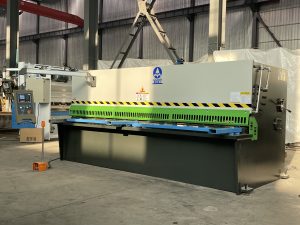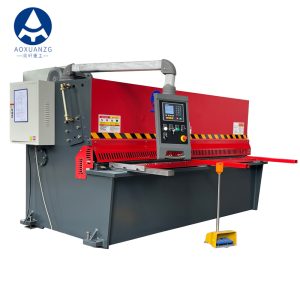In the realm of metal fabrication and sheet metal processing, shearing machines play a pivotal role. They are the workhorses that cut and shape materials to precise sizes, ensuring high-quality output for a wide range of applications. Two predominant types of shearing machines used in the industry are mechanical and hydraulic. To fully grasp their functionalities and applications, let’s explore the distinctive features of each.

Mechanical Shearing Machines: Simplicity in Action
Core Principles
Mechanical shearing machines rely on the mechanical advantage provided by a flywheel and crank mechanism to generate the force necessary for shearing. The operator manually controls the cutting action, which is achieved through a system of levers and gears that convert the mechanical energy into the linear motion of the cutting blade.
Benefits and Drawbacks
Advantages:
– Cost-Efficiency: Mechanical shearing machines are typically less expensive to purchase and maintain due to their simpler design and lack of hydraulic components.
– Ease of Use: The straightforward operation requires minimal training, making it accessible to a broader range of operators.
– Energy Conservation: Since they do not rely on electricity or hydraulic pressure, they can conserve energy in environments where power is limited.
Limitations:
– Limited Cutting Capacity: Mechanical machines are generally suited for lighter gauge materials due to the natural limits of mechanical force generation.
– Physical Demand: The operation may require more physical effort from the operator, especially for prolonged use.

Hydraulic Shearing Machines: Power and Precision at Work
Operational Insights
Hydraulic shearing machines harness the power of pressurized fluid to drive the cutting action. The hydraulic system, which includes a pump, valves, and a hydraulic cylinder, provides a high degree of force and control. This allows for the cutting of thicker materials with greater precision and less effort from the operator.
Advantages and Considerations
Advantages:
– High Cutting Force: The hydraulic system can deliver substantial force, making it capable of shearing through materials that are too thick or hard for mechanical machines.
– Precision and Control: The hydraulic system allows for fine-tuning of the cutting force and angle, resulting in more accurate and clean cuts.
– Less Physical Strain: The operator benefits from the machine’s automated and controlled cutting action, reducing the physical demands of the task.
Considerations:
– Higher Initial Investment: The complexity of hydraulic systems translates to a higher purchase price and potentially more expensive maintenance.
– Maintenance Requirements: Regular checks and maintenance are crucial to ensure the hydraulic fluid is clean and the system is functioning optimally.
Choosing the Right Shearing Machine
The choice between a mechanical and hydraulic shearing machine depends on several factors, including the material being cut, the thickness and strength of the material, the precision required for the cut, and the budget available for equipment purchase and maintenance.
– For workshops and facilities that work primarily with lighter gauge materials and require a cost-effective solution, a mechanical shearing machine may be the best fit.
– Conversely, for heavy-duty operations dealing with thicker materials and requiring high precision, a hydraulic shearing machine would be more appropriate.
Both mechanical and hydraulic shearing machines serve the metalworking industry with their unique strengths. The mechanical shearing machine, with its simplicity and cost-effectiveness, is an excellent choice for lighter cutting tasks. In contrast, the hydraulic shearing machine’s power and precision make it ideal for more demanding applications.
Understanding the operational principles, advantages, and limitations of each type is crucial for making an informed decision that aligns with the specific needs of a project or a production facility. By carefully considering these factors, manufacturers can select the most suitable shearing machine to enhance their productivity and ensure the highest quality of work.

